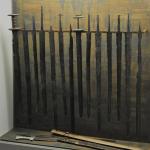________________
L.V. Nazarova
Director of MUDOD
MDT "Firefly"
G. Rtishchevo
Saratov region.
Municipal educational institution of additional education for children - "Center for children's creativity" Firefly "
rtishchevo, Saratov region.
Synopsis of the open lesson in the section "Learning to sculpt
in the preschool group “Droplets”
Topic : “Aquarium fish”
Date and time: April 23, 2010 9.00
Location: Cabinet "Droplets
Developed and implemented:
teacher before
M.A. Sidorova
2012 year
Targets and goals:
- to improve the ability to work with plasticine using the relief sculpting technique;
- continue to develop creative independence, cause a desire to fantasize;
- learn to attach plasticine to cardboard;
- to fix skills in the image of plasticine fish;
- achieve a harmonious combination of primary and secondary colors;
- to educate in children aesthetic taste, imaginative vision, love of nature.
Equipment:
- scheme of plasticine (on the board);
- pictures of aquarium fish (children's manual);
- fish (in the "aquarium");
- work flow chart (at the desk);
- "Aquarium" (on the board)
- plasticine, oilcloth, plank, napkin, stack (on the desk).
Preparatory work:
Talk about aquatic and aquarium inhabitants.
Lesson plan.
- Org moment. (1 minute)
- Learning new material. (5 minutes)
- Warm up for the fingers. (6min).
- The practical part. (10 minutes)
- Gym
- Creative work (5min)
- Game "Fisherman"
- Total. (3 min)
LESSON COURSE
1. Organizational moment
Children go into the office, go to their jobs. Children sit at their desks. At the desks - oilcloths, planks, plasticine (yellow, orange, white, black, red), stacks, napkins.
Teacher: Guys, today we have an unusual activity. See how many guests we have. Let's say hello and smile at them.
You will learn the topic of the lesson if you solve a riddle. Listen to her carefully.
Look at the house standing
Poured water to the brim,
Without windows, but not gloomy,
On four sides transparent.
In this house the tenants
All skilled swimmers.
- Who guessed what it is? (aquarium). Right.
2. Introduction
Teacher:
See which aquarium I brought you today.
(showing the blank of the aquarium)
What is in the aquarium?
(sand, pebbles, shells, seaweed, fish)
Why are they needed? (So that the fish feel at ease).
The fish is sad, but why do you think so?
(children's answers)
1. Can she be sad for what guys can eat?
2. And what do you think, can she be sad because the water in the aquarium is dirty? And now I will teach you how to clean water if it is dirty.
Experience
Water can be cleaned with a filter.
Look in this jar of dirty water. We will clean it with a filter that you can do yourself. It consists of gauze cotton wool. In the funnel, I put cotton and gauze. And pour water. See what happened? Is the water clean? And the dirt remained on gauze and cotton wool.
3. She is sad that she has no friends.
What can fish friends be made of? (dazzle, cut out of colored paper, draw).
Today I propose to mold fish from plasticine using the relief sculpting technique.
Who knows which fish live in the aquarium? (kids call)
Look what kind of fish I brought today.
(showing illustrations of aquarium fish, call them)
Angelfish, guppies, gourami, swordsman, golden, catfish, barbus.
Before starting work, we will warm our hands a little.
3. Warm up. Finger gymnastics "Fish"
(The fingers of both hands are folded with “pinch.” The hands move in a wave from the shoulder, representing diving fish.)
Fish swam, dived
In clean, warm water.
They will shrink(On the last word, the fingers tighten together very tightly.)
Unclench (Fingers are widely spread out to the sides.)
That burrow in the sand.(Clasping fingers together, hands alternately make movements, as if digging up sand).
4. The practical part
a) Explanation of safety precautions:
On your desk there is a tool unsafe in operation, what? (stack)
Right. Let's remember the rules of safe work when modeling clay:
- you can not play with the stack, it should lie on the edge of the table;
- use the stack only when necessary;
- do not put clay on the table, only on an oilcloth or a plank;
- do not throw plasticine on the floor;
- do not take clay in your mouth;
B) You have fish modeling schemes on your tables.
Analysis of schemes individually.
Guys, pay attention to the schemes on your tables. Making a fish consists of 3 parts: head, trunk, tail, fins and eyes.
So, we met with the fish modeling scheme.
c) We begin the independent work of children from the first part (from the head).
5.Dynamic pause (10-15 minutes after the start of work).
RIVER
We went down to the fast river,(walking on the spot)
Bent over and washed.(leaning forward)
One two three four,
That's how gloriously freshened up.(clapping)
And now they sailed together
Do this with your hands:(circular movements of the hands)
Together, it's breaststroke
One, the other is a crawl.
All as one
We swim like a dolphin.
Steep ashore (jumping in place)
And went home.(walking on the spot)
6. Creative work
a) Individual work with children during independent activities.
b) Product design(children finished products with the help of a teacher are placed in the "aquarium").
7. The game "Fisherman"
The game is held with those guys who have finished their work.
Teacher: The guys who did everything, the fish invites you to play a game. Probably each of you would like to catch a goldfish? (Yes). And today your dream will come true? I need two members. You need to catch the goldfish faster than anyone, reeling up the glomerulus, the fish will come closer when it is in your hands, then you are a real fisherman. For this, the fish will fulfill your three wishes.
8. Analysis of work. Summarizing the lesson
The teacher notes the “+” and “-” of the children’s works, wonders who liked the lesson and vice versa, who and what difficulties they encountered in making the fish. An exhibition of works is organized ("Aquarium"). The guys attach their work to the "aquarium".
What a wonderful aquarium we got.
What have we learned to do today? (purify water, sculpt fish)
What technique? (Embossed molding)
What did we need to make such beautiful fish?
Look carefully at your work, have you done everything right?
What did you like today in class?
Anyone remember the names of aquarium fish? (children's answers).
The fish is very satisfied. She thanks you for the fact that you are kind and responsive, that you tried very hard and made many beautiful friends.
Wonderful work. Your fish are real. All well done, the lesson is over. Build in pairs.
Plasticine "The Tale of the Fisherman and the Fish" do it yourself. Master class with step by step photos
Samoilenko Tamara Vladimirovna, defectologist teacher KOU VO "Borisoglebskaya boarding school for orphans and children left without parental care of parents with disabilities."The master class is designed for primary school children, teachers of preschool and additional education, teachers, children and their parents.
Appointment: characters for puppet theater, participation in school exhibitions, in fairy tale therapy classes
Goal: creating images of the Old Man and
Tasks:
- to acquaint children with Pushkin's fairy tale, the character of the main characters.
- improve the modeling technique
- development of children's creative abilities, attention, imagination and fantasy;
- development of fine motor skills, eye measurement;
- education perseverance, accuracy, interest in working with plasticine
- DIY craft training
Description: work can be done with children of primary and secondary school age. The material may be useful to teachers of preschool and continuing education, teachers, children and their parents.
Tales of Pushkin
From childhood we know
According to the tales of friends
We choose for ourselves.
We grew up with them
And the enemies were distinguished
In life with fairy tales
Pushkin walked,
Were friends, loved
Laughing, joking
And in Pushkin's tales
Heroes were loved.
There is a fairy tale about a fisherman,
His wife is an old woman,
I was not happy with everything:
I didn’t want to be a peasant
I didn’t want to be a noblewoman
I didn’t want to be a queen.
She had a dream -
Become the mistress of the sea,
But the mistress of the sea
The old woman could not become
She wanted a lot
And to the broken trough
Her greed led.

"The Tale of the Fisherman and the Fish" was written by Alexander Pushkin on October 14, 1833 and was first published in the journal "Library for Reading" in May 1835.
The plot of the tale is based on Russian folk tale “The greedy old woman” also echoes the Pomeranian fairy tale “About the Fisherman and His Wife” from the collection of fairy tales by the Brothers Grimm.
The charm of fabulous fiction in all its strength was first felt by Alexander Sergeyevich Pushkin. He led the tale from the category of secondary literature, as it remained before him. From Mikhailovsky he wrote to his brother: “What a beauty these tales are! Each is a poem. ” The poet’s own tales kept the main thing in themselves - the charm and freedom of a fairy tale miracle.
The name of Pushkin, the features of his face enter our minds in early childhood, and the first time we hear poems or fairy tales we carry with us through our whole lives. Pushkin lived in the heyday of an oral fairy tale, talked with many storytellers, saw the creative manner of various performers, so the fairy tale became one of the most interesting trends in his work. Pushkin's tales are the direct successors of folk tales, but not imitation of them.
The tale condemns the desire to rise above its wretched state. The old woman wants to get a new house instead of a dugout, then become a mistress from a peasant woman, and then a queen.
In Pushkin's tale, the fate of the old man is separated from the fate of the old woman; he still remains a simple peasant fisherman, and the higher the old woman ascends the "social ladder", the harder the oppression experienced by the old man becomes. The old woman at Pushkin was punished not for the fact that she wants to live as a mistress or queen, but because, having become a mistress, she beats and "drags for chuprun" her servants, sends her husband a peasant to serve at the stable; Having become a queen, she is surrounded by a formidable guard who almost chopped up her old man with axes, she wants to be the mistress of the sea so that the goldfish serves her and is on her premises. This gives Pushkin's tale a deep progressive meaning.
The tale is written in a special poem created by Pushkin, with which he wrote one of "Songs about Stenka Razin" ("Like the Volga-rock on the wide ...") and most of the "Songs of the Western Slavs".

In my work, I tried to convey the image of an old working man with a hunched back, but a good soul, to whom, like magic, his Golden Sorceress Rybka got into his network.
Before starting work, I introduced the children to Pushkin's tale, the students decided on the character of the main characters, got acquainted with the drawings of Bilibin. And also I had conversations about greed and virtue, work and kindness. The children themselves illustrated a fairy tale, an exhibition of children's works was organized. And then they decided to mold the heroes they liked.

Working process.
For work, we need: a sheet of colored cardboard, plasticine, a stack, scissors, glue, a pencil, a plate, a painting net.
Time spent wisely on children is compensated by adult love, good mood and health. Realizing this motto, you can safely take advantage of a master class on making a pretty picture. Making a fish. Not gold, but plasticine. But from this, it will not seem less valuable to you. On the contrary, not only the result of needlework, but the process itself will unexpectedly please even an adult. The work perfectly develops the motor skills of children's hands, attention, accuracy and creative skills. Do not limit the child’s imagination regarding the choice of color, shape of details. Then his creation can easily surpass what is proposed below.
Materials needed for crafts:
- plasticine;
- a sheet of thick cardboard;
- a solid work surface or a special board.
How to mold a plasticine fish.
1. Hands on the plank roll a long thin roller. It will be used for contour.
2. From the finished roller on the cardboard laid out the external circuit. Presses lightly with your fingers. If the child does this on his own, you can pre-draw the fish with a pencil. Then it remains only to glue the plasticine roller along the intended line.

3. A small piece of plasticine, contrasting in color from the contour, is well stretched with hands. The head of the fish is outlined: the plasticine is rubbed directly on the cardboard with fingers. A previously prepared roller is used to trim the head.

4. Cooking scales. To do this, several dozen balls of the same size in different colors are needed.
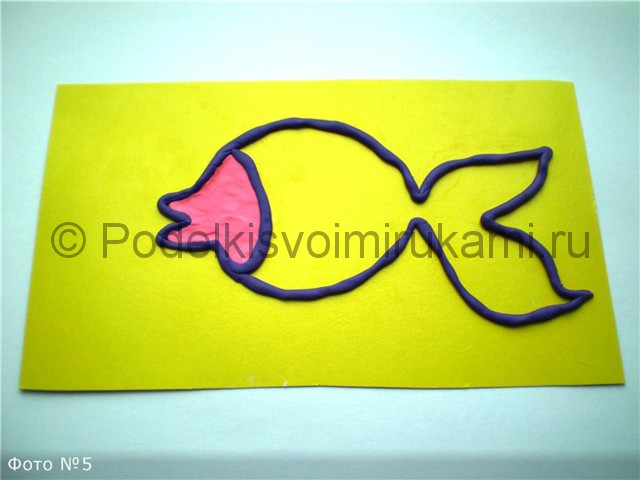
5. Starting from the tail of the fish, scales are glued. This should be done in alternating rows. When applying a ball to cardboard, it must be pressed. Thus, almost real flat flakes are obtained.

6. Now you need to make an eye. You will need three balls of different sizes: larger white, smaller blue, the smallest black. Balls are glued with a slide, slightly pressed together by fingers.

7. The tail and fins are formed. Long thin rollers are again needed. Better if they will be a variety of colors.
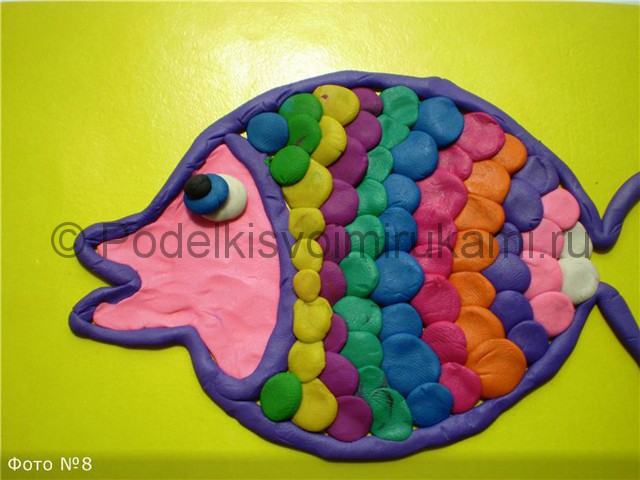
8. To form the tail, you need to glue the prepared rollers, placing them one by one along the contour.


9. Fins are attached in appropriate places. You can add water bubbles.
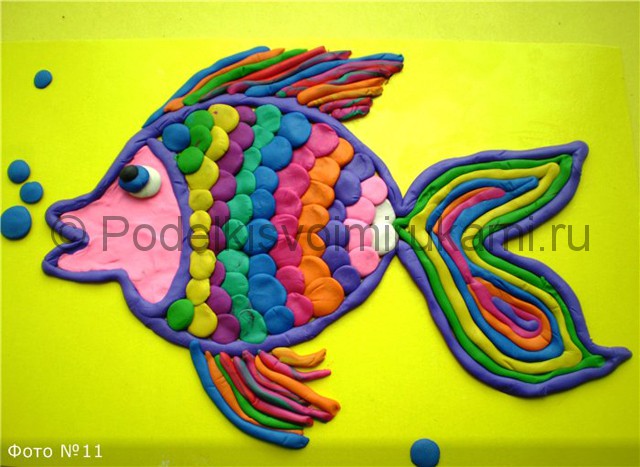
The final form of crafts. Photo 1.

The final form of crafts. Photo 2.
This craft is the broadest field for a fantasy walk. You can add algae, stones and shells, treasures of sunken ships and sea monsters - all that comes to mind. From this picture will only benefit.
Modeling plasticine fish is an interesting and creative activity for children from 3 to 10 years old. The simple body shape of these marine inhabitants allows even babies to cope with such work. And for older children it will be an interesting task to decorate their plasticine models. We offer several options for sculpting fish from plasticine. Models are arranged in increasing difficulty. For work, it is best to take bright colours, and for decorative details - contrasting, additional. For example, blue and yellow, orange and green. Plasticine fish can be stuck on a sheet of paper, designed as a seabed. If such a paper “sea” is large enough, then in kindergarten you can do an excellent teamwork.
Modeling very simple plasticine fish
This is a very simple option! Children of 3-4 years old will be able to mold such fish from clay. It is interesting to perform it from the "marble" plasticine. In order to make such plasticine, you need to take several (two to three) multi-colored pieces of plasticine and mix them. Usually, children like to make such a “color jumble”.
Roll up the sausage and fold it with a “loop”. In fact, the fish is ready. It remains only to decorate it.

The first option is to flatten the “trunk” with the thumb and forefinger. If you want, we’ll stick an eye and fins, print “scales” on plasticine, for example, a cocktail tube.

With another design option, a rather avant-garde fish from plasticine is obtained. But the kids like it. We form the lower and upper fins by pinching. About this and other ways to work with plasticine, see the article. We put eyes on and the fish is ready.
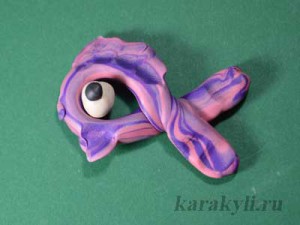
Ready-made plasticine fish can be settled in.
Modeling of fish from plasticine based on a ball or ellipsoid.
These plasticine fish are a model for children 5-7 years old. We show modeling on two fish at once. The blue fish made on the basis of the ball is simpler, the red fish based on the ellipsoid is a little more complicated.
We roll a ball or testicle-ellipsoid from plasticine. Flatten the figures.

We roll a sausage from yellow plasticine, slightly flatten it and stick it to the back of the fish. This is the upper fin. You can cut the upper fin stack.
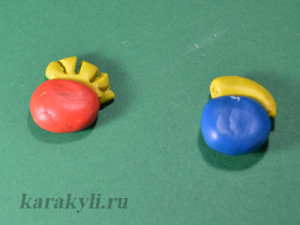
We make a fishtail. We roll a ball (blue fish) or a “carrot” cone (red fish) from yellow plasticine. Flatten and grease the tail of the fish. With a stack we apply a notch pattern or cut a tail.
Plasticine red, yellow, white, black; beads, small buttons, sparkles, beans, peas, felt-tip caps, plastic forks, coarse fabric for fingerprints, toothpicks, stacks, coarse fabric for prints, boxes, bubbles, cookie cutters, napkins, paper or cloth, oilcloth.
Fish can be sculpted in various ways. Roll up the ball, slightly extend and flatten it to get a fish torso. Pull the tail, pinch the fins, scratch the scales with a stack. You can mold a fish in the same way from an ovoid and a cone. This method is called sculptural.
And if we want to sculpt a fish from parts: a body from one piece, a tail and fins from another, then this will be a constructive way. Combine the two methods and get a new one - combined.
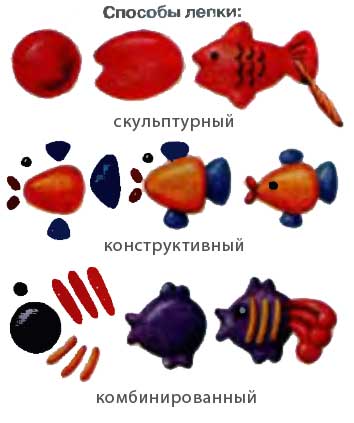
Now let's see how important the details are in sculpting. From the same flattened forms comes a huge variety of different fish. Roll out the ball. flattened - we get the simplest body shape for our fish.

And how it comes out depends on the details. The tail and fins can simply be pulled out of the body and scratched with a stack or dazzled parts separately and attached to the body. And you can also make the body in the form of an egg, sausage, cucumber, pear, carrot, etc.

